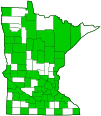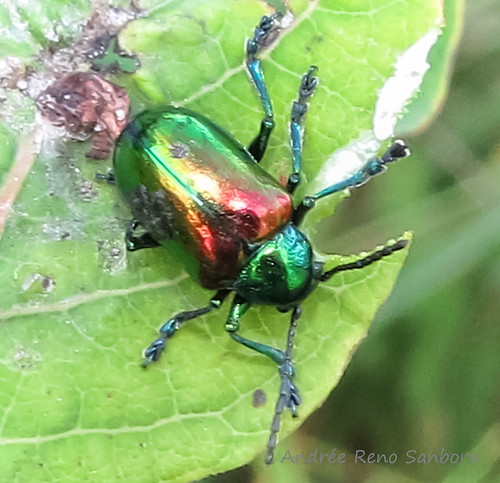dogbane beetle
(Chrysochus auratus)
Conservation • Description • Habitat • Ecology • Distribution • Taxonomy
Conservation Status |
|
|||||||
| IUCN Red List | not listed |
|||||||
| NatureServe | NNR - Unranked |
|||||||
| Minnesota | not listed |
|||||||
Description |
||
The body is oval-shaped, strongly convex, bluish-green, and shiny. The hardened wing covers (elytra) have a coppery, brassy, or bluish sheen. The head and thorax are bright metallic green and shiny. The antennae are thread-like, bluish-black, and widely separated at the base. They have 12 segments and are less than half as long as the body. The legs are bluish-black. The part of the leg that corresponds to a foot (tarsus) has five segments, but appears to have only four because the fourth segment is very small. The larvae are called rootworms. They have a white body and brown head. |
||
Size |
||
Total length: 5 ⁄16″to 7 ⁄16″ |
||
Similar Species |
||
Habitat |
||
Anywhere the host plants are found |
||
Ecology |
||
Season |
||
Early summer to fall |
||
Behavior |
||
When disturbed, it drops to the ground and attempts to hide in the leaf litter. If handled, it may exude a foul-smelling secretion. |
||
Life Cycle |
||
Masses of yellow eggs are laid in the summer on the ground or on leaves and stems of the host plant. When the eggs hatch, the larvae drop to the ground and burrow into the soil, where they feed on the roots of the same plant. They pupate in the soil and emerge the following early summer as adults. |
||
Larva Food |
||
Roots of mostly Indian hemp and spreading dogbane; occasionally milkweed |
||
Adult Food |
||
Leaves of mostly Indian hemp and spreading dogbane; occasionally milkweed |
||
Distribution |
||||
|
Sources |
|||
| 8/1/2022 | ||||
Occurrence |
||||
Common |
||||
Taxonomy |
|||
Order |
Coleoptera (Beetles) | ||
Suborder |
Polyphaga (Water, Rove, Scarab, Long-horned, Leaf, and Snout Beetles) | ||
Infraorder |
Cucujiformia | ||
Superfamily |
Chrysomeloidea (leaf beetles and allies) | ||
Family |
Chrysomelidae (leaf beetles) | ||
Subfamily |
Eumolpinae (oval leaf beetles) | ||
Tribe |
Eumolpini | ||
Genus |
Chrysochus | ||
Synonyms |
|||
|
|||
Common Names |
|||
dogbane beetle dogbane leaf beetle |
|||
Glossary
Elytra
The hardened or leathery forewings of beetles used to protect the fragile hindwings, which are used for flying. Singular: elytron.
Tarsus
On insects, the last two to five subdivisions of the leg, attached to the tibia; the foot. On spiders, the last segment of the leg. Plural: tarsi.
Visitor Photos |
|||||
Share your photo of this insect. |
|||||
| This button not working for you? Simply email us at info@MinnesotaSeasons.com. Attach one or more photos and, if you like, a caption. |
|||||
Glen Young |
|||||
our neighbor has many milkweed plants on his beach and this beetle landed on my leg. |
|||||
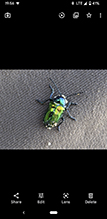 |
|||||
Mike Poeppe |
|||||
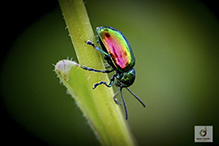 |
|||||
Dan W. Andree |
|||||
| Cool little beetles. They can turn several different shades of metallic colors depending on the day lighting and surroundings. I have even seen them with metallic reds on them. | 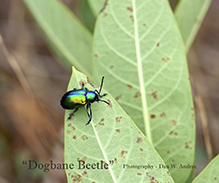 |
||||
Dogbane beetle in hand |
|||||
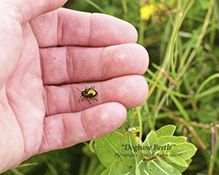 |
|||||
MinnesotaSeasons.com Photos |
|||||
|
|||||

Visitor Videos |
|||
Share your video of this mammal. |
|||
| This button not working for you? Simply email us at info@MinnesotaSeasons.com. Attach a video, a YouTube link, or a cloud storage link. |
|||
Dan W. Andree |
|||
| "The Dogbane Beetle" Nature Music video Published on Sep 17, 2016 |
|||
About
Published on Sep 17, 2016 I came across this colorful little beetle for the first time late this summer. The Dogbane is small metallic colored beetle not that much bigger than a ladybug. It averages 3/8 to 1/2 inch in size. I found them to be interesting, harmless - even what appeared to be napping at times and quite colorful. Filmed from Aug. 15th to Sept. 3rd - 2016. Background music added. |
|||
Other Videos |
|||
| Dogbane beetle cleans latex sap from mouth Bug of the Week |
|||
About
Published on Jul 18, 2016 When the goop is just too much to handle, a backward stroll helps the dogbane beetle to rid its mouthparts of sticky latex. |
|||
| Dogbane Leaf Beetle Jacob Kramer |
|||
About
Published on Aug 13, 2013 The Dogbane Leaf beetles' iridescence is produced by special body structures and light. The surface of the body parts of this beetle is made up of stacks of tiny, slanting plates, under which is a pigment (substance that produces color). Some light rays reflect from the surface of the plates, and other light rays reflect from the pigment underneath. At different angles, the light reflects at different speeds, causing interference and resulting in our seeing different colors that shine. Description: |
|||
| Dogbane Leaf Beetle Nature Walks with Mark Fraser nwwmark |
|||
About
Published on Feb 7, 2010 I am often amazed at the incredible colors that can be found within nature. Some species are actually colored in a jaw - dropping metallic iridescence. One of the best examples of that, has to be the Dogbane Leaf Beetle seen on this film! Like their names sake, they spend most of their entire lives feeding on the Dogbane and also on the milkweed plant. They will lay their eggs at the base of the host plant, and when the larvae hatch they will burrow in the soil feeding on the roots. As they reach their adult stage, they spend their lives feeding on the greenery in a world of beautiful iridescent beetles! There are many possible uses for their breathtaking coloration, the one I think is the most intriguing is communication. As they move about the metallic iridescent colors will change from glowing greens to reds and even bronze. They are another great example of the beauty of the natural world and truly amazing to admire. I'm Mark Fraser and to read up on more exciting adventures studying our incredible wild neighbors join me at http://www.naturewalkswithmark.org |
|||


Last Updated:
